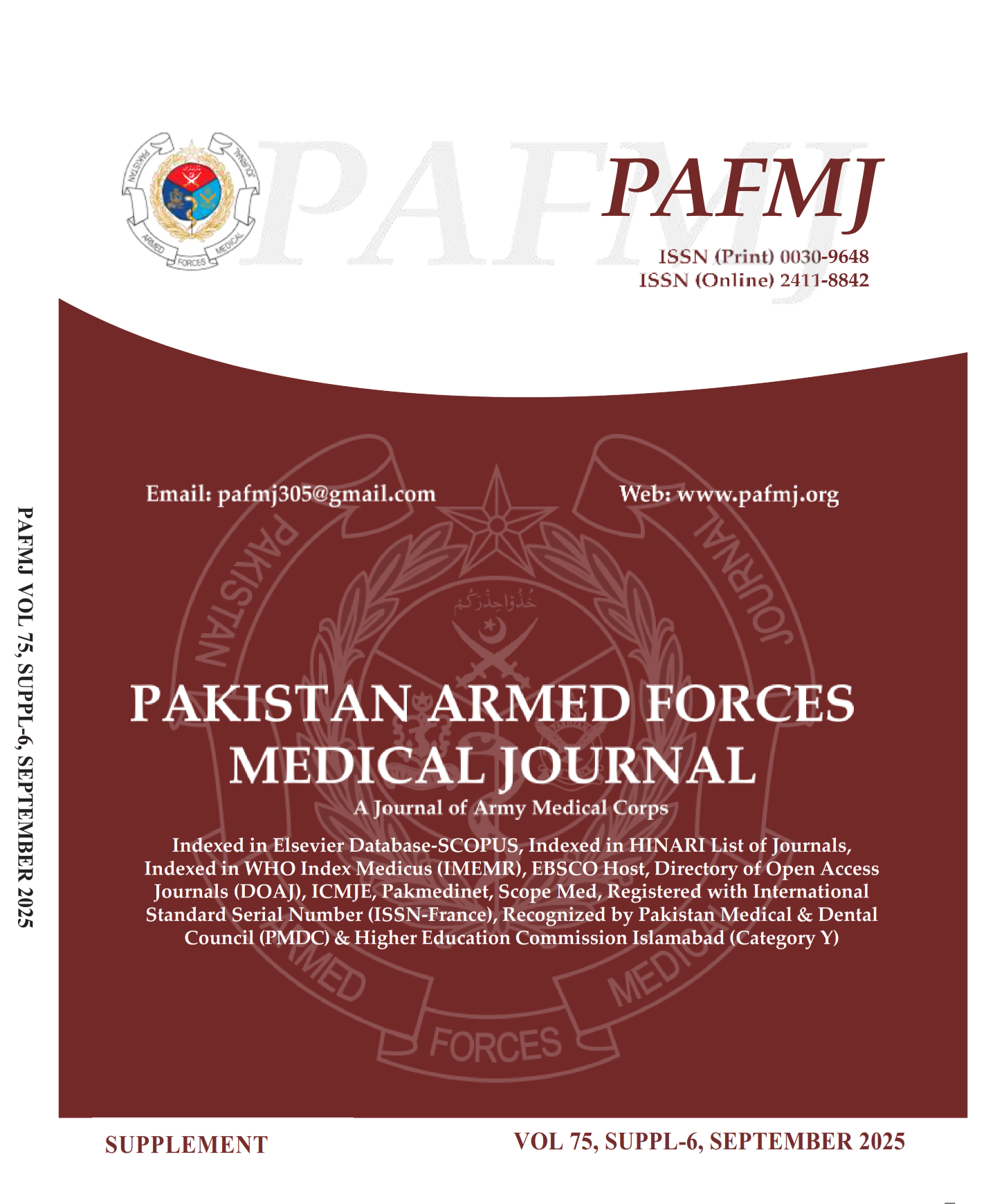Performance Evaluation of Fully Automated Reticulocyte Count As A Validated Method In Comparison with Manual Count In Neonates
DOI:
https://doi.org/10.51253/pafmj.v75iSUPPL-6.8010Keywords:
Reticulocyte count, Automation, Haematology analyzers.Abstract
Objective: To evaluate the performance of fully automated reticulocyte count as a validated method in comparison with manual count in neonates.
Study Design: cross-sectional study.
Place and Duration of Study: Department of Haematology, Armed Forces Institute of Pathology (AFIP), from July 2020 to December 2020.
Methodology: 103 healthy neonates of either gender were selected using non-probability convenience sampling. Venous blood of the participants was collected and reticulocyte count was determined using both manual count as well as Sysmex XN-3000 Automated Haematology Analyzer. The data was recorded, tabulated and processed to ascertain the degree of correlation and agreement between the two methods using Linear Regression Analysis and Bland-Altman plot respectively.
Results: The mean age of participants was 14 days. Out of the total of 103 participants, gender-wise distribution was 55(53%) males and 48(47%) females. The mean manual reticulocyte count was 2.0+1.1% and automated reticulocyte count was 2.0+ 1.0%. The two sets of data showed good correlation with a coefficient of correlation (r) of 0.97. The mean bias of data was 0.002 with good agreement as all recorded data points fell between upper and lower limits of agreement.
Conclusion: Our findings suggest that automated haematology analyzers can offer a high-throughput method of determining reticulocyte count with an adequately close agreement of results to the well-established manual method.
Downloads
References
Ovchynnikova E, Aglialoro F, von Lindern M, van den Akker E. The shape shifting story of reticulocyte maturation. Front Physiol. 2018; 9: 829.
2. Moras M, Lefevre SD, Ostuni MA. From erythroblasts to mature red blood cells: Organelle clearance in mammals. Front Physiol [Internet]. 2017; 8. Available from:
http://dx.doi.org/10.3389/fphys.2017.01076.
3. Zimbelman JD. Normocytic and macrocytic anemia. In: Berman’s Pediatric Decision Making. Elsevier; 2011. p. 600–1.
4. Koepke JF, Koepke JA. Reticulocytes. Clin Lab Haematol. 1986; 8(3): 169–79.
5. Riley RS, Ben-Ezra JM, Goel R, Tidwell A. Reticulocytes and reticulocyte enumeration. J Clin Lab Anal. 2001; 15(5): 267–94.
6. Piva E, Brugnara C, Chiandetti L, Plebani M. Automated reticulocyte counting: state of the art and clinical applications in the evaluation of erythropoiesis. J Clin Chem Lab Med. 2010; 48(10): 1369–80.
7. Adane T. Clinical utility of immature reticulocyte fraction. J Clin Chem Lab Med. 2021; 4: p172.
8. Ahmed T, Mahmood A, Uddin N, Robert HM, Mahmood R, Swati UT. Diagnostic Significance of Measuring Reticulocyte Maturity Indices in Iron Deficiency Anaemia. Pak Armed Forces Med J 2021; 71(6): 2019-2113.
9. Velasco-Rodríguez D, Alonso-Domínguez J-M, González-Fernández FA, Villarrubia J, Sopeña M, Abalo L, et al. Reticulocyte parameters of delta beta thalassaemia trait, beta thalassaemia trait and iron deficiency anaemia. J Clin Pathol [Internet]. 2016; 69(2): 149–54. Available from: http://dx.doi.org/10.1136/jclinpath-2015-203034.
10. Altman DG, Bland JM. Assessing agreement between methods of measurement. Clin Chem. 2017; 63(10): 1653–4.
11. Monti CB, Ambrogi F, Sardanelli F. Sample size calculation for data reliability and diagnostic performance: a go-to review. Eur Radiol Exp. 2024 Jul 5; 8(1): 79. doi: 10.1186/s41747-024-00474-w.
12. Dacie and Lewis Practical Haematology. 12th ed. London, England: Elsevier Health Sciences; 2016.
13. Lippi G, Da Rin G. Advantages and limitations of total laboratory automation: a personal overview. J Clin Chem Lab Med. 2019;57(6):802–11.
14. Pandis N. Why using a paired t-test to assess agreement is problematic? Am J Orthod Dentofacial Orthop. 2021; 160(5): 767–8.
15. Simionatto M, de Paula JP, Chaves MAF, Bortoloso M, Cicchetti D, Leonart MSS, et al. Manual and automated reticulocyte counts. Hematology. 2010; 15(6): 406–9.
16. Ali AF, Moiz B, Omer S. Is manual reticulocyte count a reliable option for under resourced countries? J Pak Med Assoc. 2010; 60(11): 892–6.
17. Patel K, Patel SM. Comparison of automated flow cytometric reticulocyte analysis with manual reticulocyte count. Int J Res Med Sci. 2019; 7(10): 3825.
18. Gangane N, Gorte T, Deshmukh A. Automated versus manual method for reticulocyte count: A comparative study in rural central India. Iraqi J Hematol. 2020; 9(2): 145.
19. George L, Basu D, Kar R. Comparison between manual and automated methods of counting reticulocytes and the effect of sample storage on reticulocyte count: A cross-sectional study from southern India. Indian J Hematol Blood Transfus [Internet]. 2021; Available from:
Downloads
Published
Issue
Section
License
Copyright (c) 2025 Usman Tahir Swati, Asad Mahmood, Saima Zahir, Manzar Bozdar, Sadia Ali, Tanweer Ahmed

This work is licensed under a Creative Commons Attribution-NonCommercial 4.0 International License.















